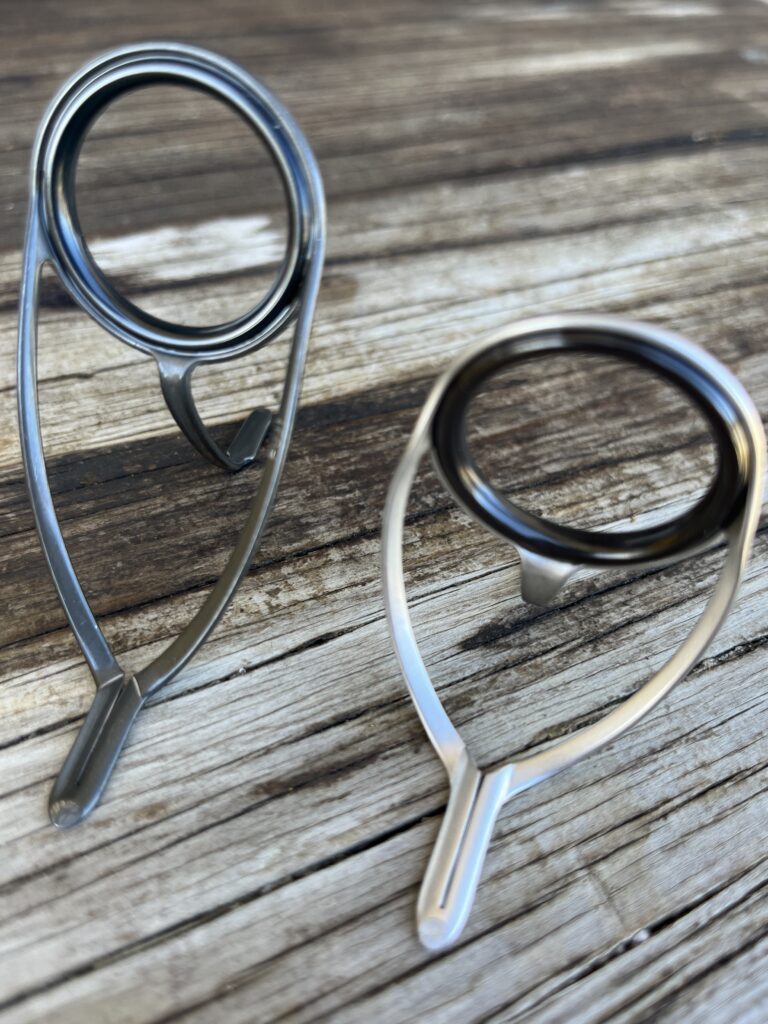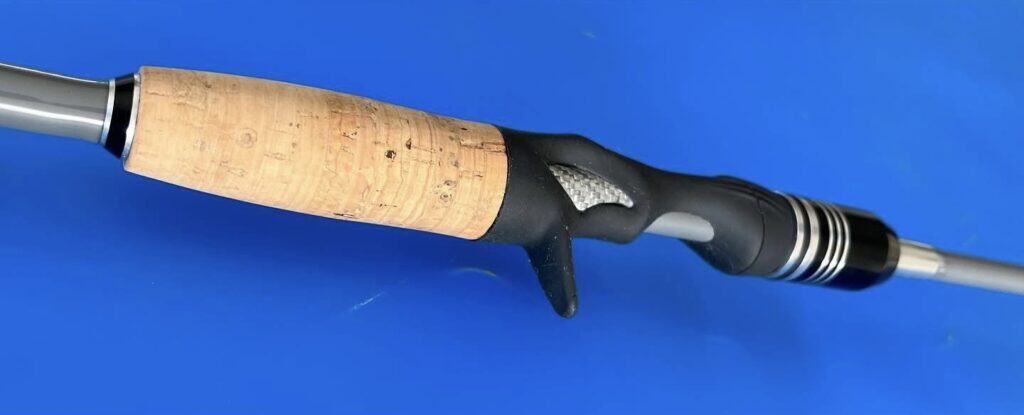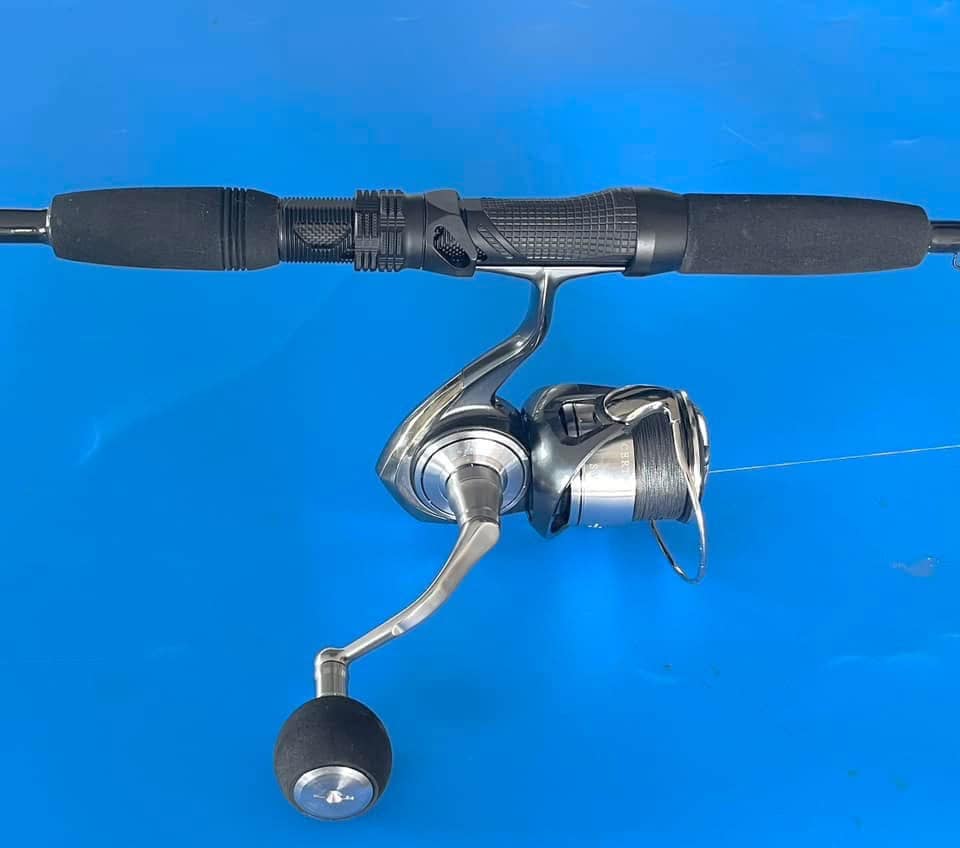
A Guide to Fishing Rod Guides: Materials, Types, and Performance
Fishing rod guides are a crucial part of a rod’s construction, playing an essential role in guiding the line off the reel and through the rod while preventing damage to the line. The design and materials of these guides can affect performance, durability, and sensitivity, making it important to choose the right guide for your fishing needs. Below, we dive deep into the different types of guides, materials used, and how they impact the fishing experience.
Types of Fishing Rod Guides
1. Single-Foot Guides
• Description: These guides have a single leg and are often used in lighter rods where weight is a concern. Single-foot guides are most commonly seen on spinning rods and fly rods.
• Pros: They reduce overall weight and increase the sensitivity of the rod, making them ideal for light tackle fishing.
• Cons: These guides may not be as durable under heavy load or when using larger fish species due to the limited structural support.
2. Double-Foot Guides
• Description: These guides have two legs, providing extra stability. Double-foot guides are most commonly found in heavier rods, such as those used for boat fishing or surfcasting.
• Pros: Increased strength and durability compared to single-foot guides, making them more suitable for heavier loads and larger fish.
• Cons: They add slightly more weight compared to single-foot guides but still allow for a balanced and sensitive rod.
3. Triple-Foot Guides
• Description: Typically seen on very heavy-duty rods, these guides feature three legs, offering the maximum support and strength.
• Pros: Perfect for heavy-duty applications like deep-sea fishing or surfcasting where large, powerful fish are targeted.
• Cons: They add the most weight, which can reduce the sensitivity and finesse of the rod, but are necessary for extreme fishing conditions.Guide Frame Materials: Types of Metal Used
The frame material of the guide determines its strength, weight, and resistance to corrosion. Here are some common metals used in guide frames:316-Grade Stainless Steel: The Best for Saltwater Corrosion Resistance
316-grade stainless steel is often referred to as marine-grade stainless steel due to its superior resistance to corrosion in marine environments. It’s made with an added element of molybdenum, which improves its resistance to saltwater corrosion, making it the best choice for fishing rods that are used in harsh saltwater conditions.
Why 316-Grade Stainless Steel Is Important for Fishing Rod Guides:
• Corrosion Resistance: The addition of molybdenum in 316-grade steel creates a highly corrosion-resistant alloy, which makes it perfect for saltwater use. This helps prevent pitting, rust, or degradation of your guides over time.
• Durability: 316-grade stainless steel is incredibly durable and can withstand the stresses and strains of heavy use, whether in freshwater or saltwater environments.
• Longevity: Investing in guides made from 316-grade stainless steel ensures that your fishing rod will last longer, as the material is highly resistant to the elements.
Why Other Grades Are Not Suitable for Saltwater:
• 304 Stainless Steel: While still corrosion-resistant, 304-grade steel lacks the added molybdenum of 316 steel, making it more vulnerable to rust and corrosion when exposed to saltwater over time.
• Other Stainless Steels: Many cheaper fishing rods may use lower-grade stainless steel in the guides, which can corrode much quicker when exposed to saltwater, leading to the degradation of the guides and a loss of performance.
Conclusion: Why Use 316-Grade Stainless Steel for Fishing Rod Guides?
If you’re serious about fishing in saltwater environments, make sure the guide frames of your rod are made from 316-grade stainless steel. It provides superior corrosion resistance, durability, and longevity, ensuring your gear withstands the rigors of frequent saltwater exposure. Always check the product specifications to confirm the steel grade used in the rod’s construction.
By using 316-grade stainless steel, you’ll keep your rod guides in prime condition, even under harsh conditions, giving you greater confidence on the water.
Titanium
• Description: Titanium guides are lightweight yet strong, offering high corrosion resistance. Titanium frames are often used in high-end rods for their light weight and durability.
• Pros: Extremely lightweight, highly resistant to corrosion, and strong.
• Cons: Expensive compared to stainless steel and other metals.
3. Aluminum Oxide
• Description: This material is often used in both frames and inserts. It offers a balance between strength, weight, and cost.
• Pros: Durable and offers decent corrosion resistance at a lower cost than titanium.
• Cons: Not as lightweight as titanium.
Fishing Rod Guide Inserts: Materials and Performance
The insert material in a fishing rod guide plays a significant role in heat dissipation, abrasion resistance, and smoothness of the line flow. Here’s a look at some popular insert materials:
1. Fuji Torzite
• Description: Torzite is a high-performance ceramic insert developed by Fuji. Known for its superior hardness and low friction, it is one of the most advanced guide inserts available today.
• Material: Torzite is made from a high-grade ceramic that provides unmatched line-smoothness and durability.
• Vickers Hardness: Torzite has a Vickers hardness of 2200 or more, making it one of the hardest insert materials available. This allows it to resist wear and tear while being able to handle high heat dissipation.
• Heat Dissipation: Torzite’s superior heat dissipation properties help prevent line damage, especially during long runs or when fighting large fish. It’s a top choice for anglers who seek ultimate performance in both fresh and saltwater conditions.
2. Daiwa AGS Guides
• Description: Daiwa’s AGS (Air Guide System) features a lightweight carbon frame, making it unique in the world of fishing guides.
• Material: The AGS guides utilize carbon fiber frames and zirconium inserts to reduce weight while maintaining strength and performance.
• Vickers Hardness: While the AGS guides use zirconium inserts (with a hardness similar to that of Fuji’s SIC), the carbon frame itself offers superb sensitivity and strength.
• Heat Dissipation: The combination of zirconium inserts and the lightweight carbon frame results in excellent heat management. The AGS guides are especially beneficial for applications where rod sensitivity and lightness are paramount.
3. Fuji Fazlite
• Description: Fuji Fazlite inserts are a more affordable yet highly durable alternative to Torzite.
• Material: The insert is made from a ceramic compound designed for high abrasion resistance and smoothness.
• Vickers Hardness: Similar to SIC, Fazlite has a Vickers hardness around 1200-1500, offering good durability and heat resistance.
• Heat Dissipation: Fazlite is effective in dissipating heat, reducing friction between the line and the guide during long casts or when reeling in large fish.4.
4 Fuji Alconite
• Description: Fuji Alconite inserts are a popular choice for mid-range fishing rods, offering a balance between performance and affordability. They are often seen in rods designed for both fresh and saltwater fishing, providing good durability and smooth line flow.
• Material: Alconite is a ceramic material that provides excellent abrasion resistance while offering a smoother finish for better casting performance. It’s a versatile option for many anglers.
• Vickers Hardness: Fuji Alconite typically has a Vickers hardness rating of around 1200-1500, making it durable enough to handle regular use while resisting wear from abrasive fishing lines.
• Heat Dissipation: Alconite is effective in dissipating heat, reducing the likelihood of line burn during long casts or heavy pressure, particularly when used for longer fishing trips or larger fish species.
5. Fuji SIC (Silicon Carbide)
• Description: Fuji SIC inserts are one of the most widely used ceramic inserts in high-performance fishing rods. SIC is known for its superior hardness and heat-resistance properties, making it a top choice for heavy-duty rods used in both freshwater and saltwater fishing.
• Material: Silicon Carbide (SIC) is a tough ceramic material that is highly resistant to both abrasion and corrosion. Its hardness ensures long-lasting performance, even in harsh environments.
• Vickers Hardness: SIC has a Vickers hardness of around 2500, making it one of the hardest inserts available. This high hardness helps reduce wear on both the insert and the fishing line, enhancing the longevity of your rod guides.
• Heat Dissipation: Due to its hardness and smooth finish, SIC is excellent at dissipating heat, making it ideal for long casting distances and situations where the line is under significant pressure.
Conclusion: Selecting the Right Guide Inserts for Your Rod
When selecting the right guide inserts for your fishing rod, consider the type of fishing you’ll be doing, the water conditions (saltwater or freshwater), and the level of durability you need.
• High-performance anglers often prefer Torzite or SIC inserts for their top-tier performance in heat dissipation and durability.
• Mid-range rods may feature Alconite or Fazlite inserts, which offer a good balance of affordability and quality.
• Daiwa AGS guides, with their carbon frame and zirconium inserts, provide lightweight strength and exceptional sensitivity for those looking to reduce weight while enhancing performance.
Additionally, ensure that your guide frames are made from 316-grade stainless steel or titanium for saltwater corrosion resistance, as these materials offer the best protection against the elements.
By understanding the differences in guide materials, you can make an informed decision and choose the right components for your fishing rod to enhance your fishing experience. Whether you’re targeting big game fish or enjoying a leisurely day on the water, the right guides will ensure that your rod performs at its best.




